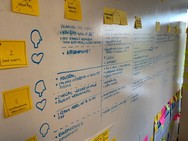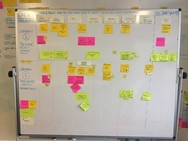
Welcome to the eleventh edition of the NHS Health Check digital exemplar project update.
You are receiving this update because you are directly involved in the exemplar or because we have identified you as someone who would be interested in our project. Please feel free to share this update with your colleagues.
To find out more about the project vision and progress to date, visit previous postcards on the NHS Health Check website.
This update covers work undertaken between 3rd June to 20th June.
|
We would like to ensure this update is relevant and useful for our audience. If you would like to provide feedback please fill in the survey. We will keep this survey open and review suggestions as they come in.
After some reflection on the wording of our design challenge we have iterated the wording to make it clearer that we are designing both for the end users of the NHS Health Check and the providers of the service. The new wording also acknowledges that in a short alpha we can only measure someone’s intent to change. Our new wording replaces the original wording which was “How might we improve the way end users receive, understand and act on their NHS Health Check results, and the way the results are delivered, to motivate necessary behaviour change?” We would welcome any feedback on the challenge to DigitalNHSHC.Project@phe.gov.uk

The user research we undertook in discovery allowed us to create user typologies, these are used to describe the types of users at a high level in terms of what they think, do and use:
think — their points of pain, delight, expectations, motivations
do — who they are, what roles they play, how they play these roles
use — tools, technology, interactions
We have been mapping these to the interaction journey to describe what the users might be thinking, feeling and doing at different stages. This is important as we know that for example; for some people the “shock” of a “bad” NHS Health Check assessment result may be a motivation for them to change, for others it may just be overwhelming.
We need to remember that providers are our users as well, and by using the insights from discovery and the literature review we are looking to see if we can develop provider typologies. These will take into account for example beliefs about prevention of ill health.
|

We know that how the NHS Health Check is delivered varies across providers, so we need to ensure our designs will work across different delivery models. We’re focusing on two main delivery scenarios:
- “All in one” - The questions, tests and results are delivered in a single appointment (where point of care testing has been used)
- “Multiple” - There may be two or more separate appointments (e.g. for blood tests and blood pressure) or one appointment then results are delivered by postal letter
Please get in touch with us at DigitalNHSHC.Project@phe.gov.uk if you have any models of delivery we may have missed.
|
As well as the primary focus of improving the NHS Health Check, during this work we are exploring how we combine the disciplines of service design with behavioural science. Since there is evidence that digital interventions underpinned by evidence-based theory of behaviour change and consisting of a greater number of Behaviour Change Techniques (BCTs) are more effective than those that are not, our plan is to develop interventions using a selection of identified BCTs. Below is an example from one of our findings indicating that the NHS Health Check can serve as a “wake up call” to change.
Target Behaviour - Patient behaviour change after NHS Health Check
Barriers and facilitators - “The NHS Health Check as a Wake-up call for change”
COM-B: Reflective motivation
TDF: Intentions
Behaviour Change Techniques that could be employed:
Goal setting (behaviour): Include space on an app/website to set a goal, e.g. get off the bus two stops early and walk the rest of the way to work)
Information about health consequences: Quotes and/or videos from patients talking about the health benefits of the changes they have made.
Incentive (outcome): On website/app include text informing patients that a financial payment will be made only if their QRisk score changes as a result of dietary/physical activity changes.

Each update we will be featuring a member of our team
As a Principal Behavioural Insights Advisor, Chryssa provides behavioural science support and advice to the NHS Health Check digital exemplar programme. She is responsible for applying behavioural science theories and frameworks across the digital service development. She works very closely with user researchers to ensure that the users can be better understood, while also collaborating with the service design team to translate this knowledge into engaging digital content. She has designed, delivered and evaluated several behavioural change research trials aiming to address key public health challenges.
Prior to joining PHE Chryssa led the delivery of collaborative intervention projects by successfully incorporating behavioural science into an agile digital service design in public health.
When she is not in the office Chryssa will most likely be spending time with friends and family or catching up with the latest movies.
|
|